
Concept explainers
(a)
Interpretation:
To accurately depict the given ball-stick model, the dash-wedge notations in the given line structure are to be added.
Concept introduction:
The dash-wedge notations are used to represent the three-dimensional arrangement of atoms or groups of molecules in plane of paper. There are three types of lines used for such arrangements, straight line, dash line, and wedge line. The straight line represents the bond is in the plane of the paper. The dash line represents the bond pointing away from the observer, that is, below the plane of paper. The wedge line represents the bond pointing towards the observer that is above the plane of paper.
Answer to Problem 2.36P
The dash-wedge notations in the given line structure is:
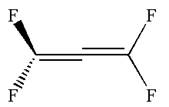
Explanation of Solution
The given ball-stick model and the line structure are:

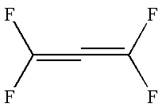
In the given ball-stick model, the yellow balls represent fluorine atoms and black balls are carbon atoms. The fluorine atoms on the left side appear in the plane of the paper. Thus, these fluorine atoms will be represented by straight lines. The two fluorine atoms on the right side are arranged such that, one fluorine atom is above the plane of paper and other is below. The one which is above the plane will be represented by a wedge bond while the one which is below the plane of the paper will be represented by a dash line.
Hence dash-wedge notation for the given molecules is shown below:
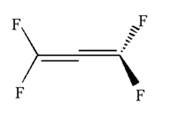
The dash-wedge notation in the given line structure is added on the basis of three dimensional arrangement given in ball-stick model.
(b)
Interpretation:
To accurately depict the given ball-stick model, the dash-wedge notations in the given line structure are to be added.
Concept introduction:
The dash-wedge notations are used while representing the three dimensional arrangement of atoms or groups of molecules on the plane of paper. There are three types of lines used for such arrangements, straight line, dash line, and wedge line. The straight line represents the bond that is in the plane of the paper. The dash line represents the bond pointing away from the observer that is below the plane of paper. The wedge line represents the bond pointing towards the observer that is above the plane of paper.
Answer to Problem 2.36P
The dash-wedge notations in the given line structure is:
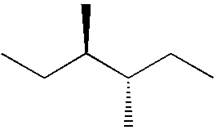
Explanation of Solution
The given ball-stick model and its line structure are:
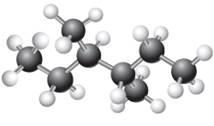
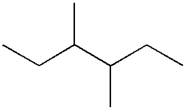
In the given ball-stick model, the white balls represent hydrogen atoms while black balls are carbon atoms. The longest continuous chain is of six carbon atoms having two methyl substituents at
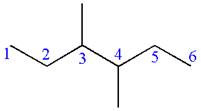
If the chain is numbered from left to right, the methyl group at
Hence, the dash-wedge notation for the given molecules is shown below:
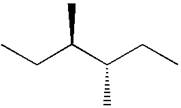
The dash-wedge notation in the given line structure is added on the basis of three dimensional arrangement given in ball-stick model.
(c)
Interpretation:
To accurately depict the given ball-stick model, the dash-wedge notations in the given line structure are to be added.
Concept introduction:
The dash-wedge notations are used while representing the three dimensional arrangement of atoms or groups of molecules on the plane of paper. There are three types of lines used for such arrangements, straight line, dash line, and wedge line. The straight line represents the bond is in the plane of paper. The dash line represents the bond pointing away from the observer that is below the plane of paper. The wedge line represents the bond pointing towards the observer that is above the plane of paper.
Answer to Problem 2.36P
The dash-wedge notations in the given line structure is:

Explanation of Solution
The given ball-stick model and its line structure are:
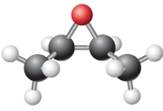

In the given ball-stick model the white balls represent hydrogen atoms, black balls represents carbon atoms and the red ball is an oxygen atom. The two carbon atoms that are directly bonded to the oxygen atom are in the plane of paper. Each of these carbon atoms has one methyl substituent and one hydrogen atom attached. Two methyl substituents points towards the observer, while the hydrogen atoms are pointing away from the observer. The bond towards the observer is considered as above the plane of the paper and is represented by wedge bond. The bond away from the observer is considered as below the plane of the paper and is represented by dash bond.
Hence dash-wedge notation for the given molecules is shown below:

The dash-wedge notation in the given line structure is added on the basis of three dimensional arrangement given in ball-stick model.
(d)
Interpretation:
To accurately depict the given ball-stick model, the dash-wedge notations in the given line structure are to be added.
Concept introduction:
The dash-wedge notations are used while representing the three dimensional arrangement of atoms or groups of molecules on the plane of paper. There are three types of lines used for such arrangements, straight line, dash line, and wedge line. The straight line represents the bond is in the plane of the paper. The dash line represents the bond pointing away from the observer that is below the plane of paper. The wedge line represents the bond pointing towards the observer that is above the plane of paper.
Answer to Problem 2.36P
The dash-wedge notations in the given line structure is:
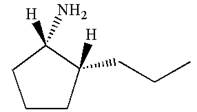
Explanation of Solution
The given ball-stick model and its line structure are:
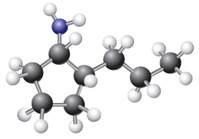
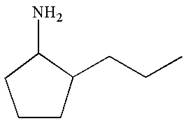
In the given ball-stick model the white balls represent hydrogen atoms, black balls are carbon atoms, and the blue ball is a nitrogen atom. The cyclopentane ring is on the plane of paper having two substituents. The
The
The second substituent is propyl group which points away from the observer and the hydrogen atoms bonded to the same carbon having propyl group is pointed towards observer.
The bond towards the observer is considered as above the plane of the paper and is represented by a wedge line. The bond away from the observer is considered as below the plane of the paper and is represented by dash line
Hence dash-wedge notation for the given molecules is shown below:
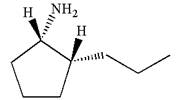
The dash-wedge notation in the given line structure is added on the basis of three dimensional arrangement given in ball-stick model.
Want to see more full solutions like this?
Chapter 2 Solutions
Organic Chemistry: Principles And Mechanisms (second Edition)
- Calculate the solubility of CaF2 in g/L (Kp = 4.0 x 10-8). sparrow_forwardFor the following reaction with excess reagent, predict the product. Be sure your answer accounts for stereochemistry. If multiple stereocenters are formed, be sure to draw all products using appropriate wedges and dashes. 1. EtLi, Et₂O CH₁ ? 2. H₂O*arrow_forwardWrite the systematic name of each organic molecule: structure 요 OH ہو۔ HO OH name X S ☐ ☐arrow_forward
- Predict the major products of this organic reaction. If there aren't any products, because nothing will happen, check the box under the drawing area instead. D ㄖˋ ید H No reaction. + 5 H₂O.* Click and drag to start drawing a structure. OH H₂Oarrow_forwardDraw one product of an elimination reaction between the molecules below. Note: There may be several correct answers. You only need to draw one of them. You do not need to draw any of the side products of the reaction 'O 10 + x 也 HO + 义 Click and drag to start drawing a structure.arrow_forwardWhat are the angles a and b in the actual molecule of which this is a Lewis structure? H- :0: C=N: b Note for advanced students: give the ideal angles, and don't worry about small differences from the ideal that might be caused by the fact that different electron groups may have slightly different sizes. a = 0° b=0 Xarrow_forward
- A student proposes the transformation below in one step of an organic synthesis. There may be one or more products missing from the right-hand side, but there are no reagents missing from the left-hand side. There may also be catalysts, small inorganic reagents, and other important reaction conditions missing from the arrow. • Is the student's transformation possible? If not, check the box under the drawing area. • If the student's transformation is possible, then complete the reaction by adding any missing products to the right-hand side, and adding required catalysts, inorganic reagents, or other important reaction conditions above and below the arrow. • You do not need to balance the reaction, but be sure every important organic reactant or product is shown. + This transformation can't be done in one step. T iarrow_forwardDetermine the structures of the missing organic molecules in the following reaction: H+ O OH H+ + H₂O ☑ ☑ Note: Molecules that share the same letter have the exact same structure. In the drawing area below, draw the skeletal ("line") structure of the missing organic molecule X. Molecule X shows up in multiple steps, but you only have to draw its structure once. Click and drag to start drawing a structure. X § ©arrow_forwardTable 1.1 Stock Standard Solutions Preparation. The amounts shown should be dissolved in 100 mL. Millipore water. Calculate the corresponding anion concentrations based on the actual weights of the reagents. Anion Amount of reagent (g) Anion Concentration (mg/L) 0.1649 Reagent Chloride NaCl Fluoride NaF 0.2210 Bromide NaBr 0.1288 Nitrate NaNO3 0.1371 Nitrite NaNO2 0.1500 Phosphate KH2PO4 0.1433 Sulfate K2SO4 0.1814arrow_forward
- Draw the structure of the pound in the provided CO as a 300-1200 37(2), 11 ( 110, and 2.5 (20arrow_forwardPlease help me with # 4 and 5. Thanks in advance!arrow_forwardA small artisanal cheesemaker is testing the acidity of their milk before it coagulates. During fermentation, bacteria produce lactic acid (K₁ = 1.4 x 104), a weak acid that helps to curdle the milk and develop flavor. The cheesemaker has measured that the developing mixture contains lactic acid at an initial concentration of 0.025 M. Your task is to calculate the pH of this mixture and determine whether it meets the required acidity for proper cheese development. To achieve the best flavor, texture and reduce/control microbial growth, the pH range needs to be between pH 4.6 and 5.0. Assumptions: Lactic acid is a monoprotic acid H H :0:0: H-C-C H :0: O-H Figure 1: Lewis Structure for Lactic Acid For simplicity, you can use the generic formula HA to represent the acid You can assume lactic acid dissociation is in water as milk is mostly water. Temperature is 25°C 1. Write the K, expression for the dissociation of lactic acid in the space provided. Do not forget to include state symbols.…arrow_forward
 Organic Chemistry: A Guided InquiryChemistryISBN:9780618974122Author:Andrei StraumanisPublisher:Cengage Learning
Organic Chemistry: A Guided InquiryChemistryISBN:9780618974122Author:Andrei StraumanisPublisher:Cengage Learning Chemistry for Today: General, Organic, and Bioche...ChemistryISBN:9781305960060Author:Spencer L. Seager, Michael R. Slabaugh, Maren S. HansenPublisher:Cengage Learning
Chemistry for Today: General, Organic, and Bioche...ChemistryISBN:9781305960060Author:Spencer L. Seager, Michael R. Slabaugh, Maren S. HansenPublisher:Cengage Learning

